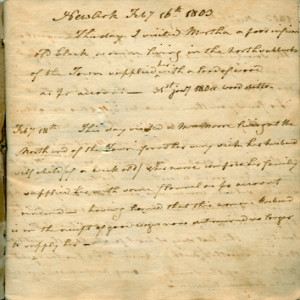Hannah Kinney’s Records of the Newark Female Charitable Society, 1803-1804
Hannah Kinney’s Records of the Newark Female Charitable Society, 1803-1804
Courtesy, New Jersey Historical Society, Newark, NJ
Kinney Family Papers, MG 785, Box 1, record books. The History of the Newark Female Charitable Society (Newark, NJ: Newark
Female Charitable Society, 1903).
Transcription
Newark, Feby 16th 1803
This day I visited Martha a poor infirm
old black woman living in the north subburbs [sic]
of the Town supplied her with a load of wood
as per amount – 31st Jany 1804 wood ditto
Feby 18th [1803] This day visited a Mrs Moore living at the
North end of the Town found her very sick her husband
& ill child of a week old / the nurse compose her family
supplied her with some flannel as per amount
[? ]– having found that the womans husband
is in the [?] of good wages now determined no longer
to supply her —
Decembr 19th 1804
Transcription
Decembr 19th 1804
This day visited an Irish Family
of the name of Dockhorty living at the old Town Dock
five in number a man woman three children under
nine years of age the youngest four–
The man having been long confined with the
Rheumatism I found them almost entirely destitute
of every comfort & they being apparently as worthy
objects as ever received the patronage of the Society
I hastened to supply them with the following articles
3 3/8 yd of Drugget @ 4/6 – 1.91
2 Yd birdseye 3/ – – – – 75
7/8 yellow flannel 3/ – – – – 21
1 load wood — — — — — 2.75
——
5.62
Feby 1st 1805 a load wood 2.00
10 – 37
The Newark Female Charitable Society was organized in January 31, 1803 for the purpose of “devis[ing] some means for caring for the poor and distressed persons in the village.” At this early date, social services were not provided by local government; yet as the town grew, so did the number of the poor in its streets. Some of the well-off women of Newark took it into their own hands to get “systematic aid to the needy.” The Society divided Newark into six districts and chose a manager to visit the poor in each. In its first year, the Society raised $246.50 from 116 contributors. Besides supplying the poor with necessities, the Society provided flax, wool, and cotton to unemployed needy folk so they could produce articles for sale.
Hannah Kinney was one of the first six managers. She kept notes of her visits and records of the supplies she purchased for the needy. The three entries included here are from her carefully kept notes. It was her responsibility to decide who in her district needed help and whether they were “worthy” of the aid of the Society. She found families in the winter without wood for heating and without the barest essentials of life. Firewood and fabrics for clothing (such as drugget, a woolen fabric, and bird’seye, a cotton fabric ) were the most common supplies she provided. The entries in Kinney’s record book give a very bleak picture of the living and health conditions for the poor at the beginning of the 19th century.


